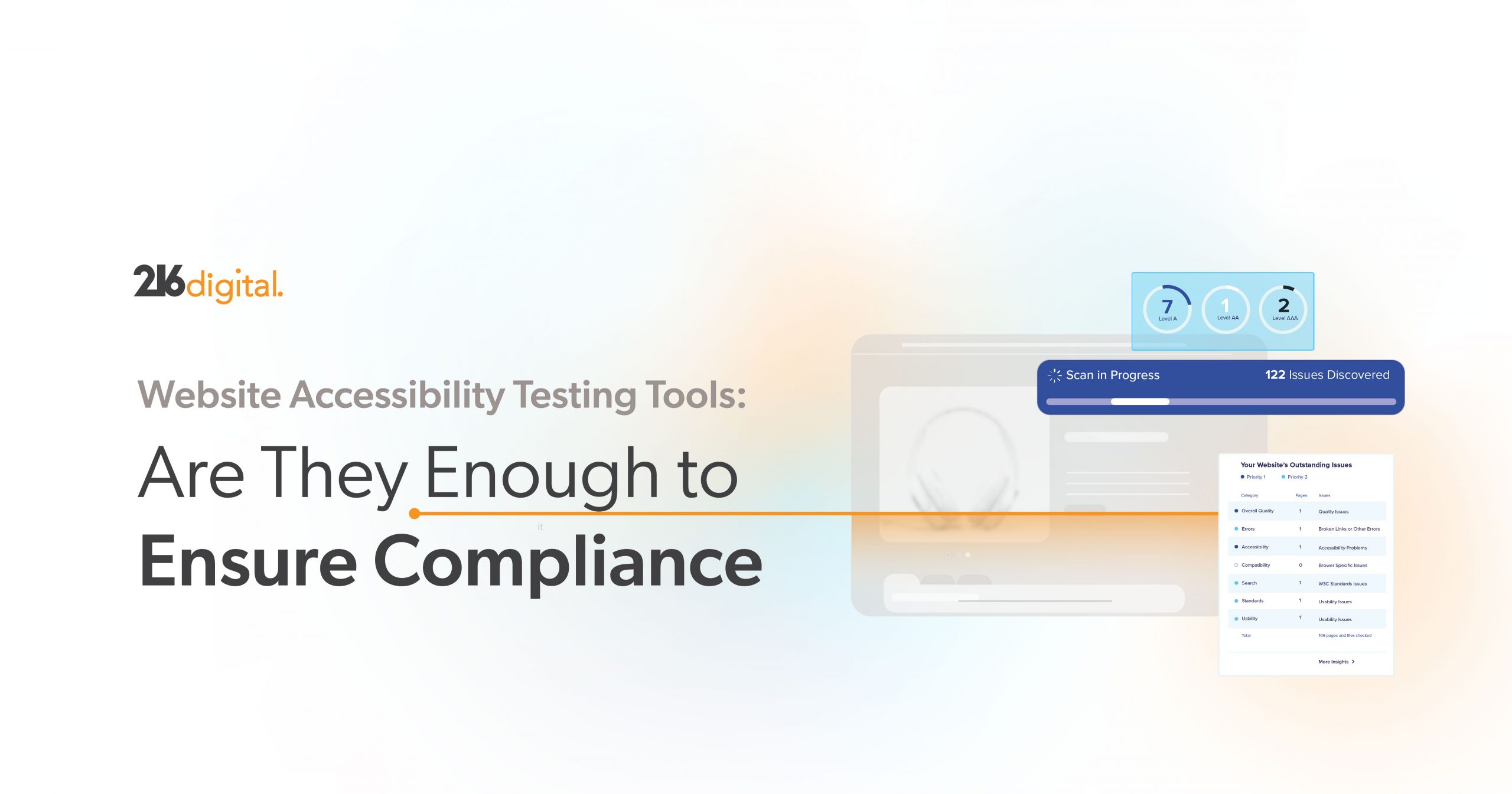As the digital world continues to evolve, many businesses are turning to Artificial Intelligence (AI) and overlay widgets to make their websites accessible. While these technologies are marketed as solutions to make websites ADA compliant, they often fail to deliver on that promise. In fact, they often make websites less accessible for those with disabilities.
What are AI and Overlay Widgets?
AI and overlay widgets work by modifying a website’s code with a snippet of JavaScript, usually in the form of a toolbar, plugin, app, or widget. However, while they claim to detect and correct web accessibility barriers dynamically, overlays do not fix the website’s source code. Instead, they can detect fundamental accessibility issues, such as color contrast and text size, to make modifications. While overlays might seem like a cheap and beneficial method for web accessibility, they do not fix the underlying code. Leaving website owners exposed to the risk of an ADA lawsuit.
Why Overlay Solutions Fail to Deliver True Web Accessibility
Many AI and overlay solutions are used as a band-aid to cover up fundamental web accessibility issues. Still, they do not resolve the critical accessibility issue. Relying on an AI or overlay tool as a long-term solution can open you to legal risk, and provide a false sense of security.
Web Accessibility Barriers Not Resolved with AI and Overlay Widgets
One of the biggest problems with AI and overlay widgets is that they do not address the inherent access barriers on websites. These technologies are designed to make websites more accessible for people with disabilities. However, they need to address the underlying issues that make websites inaccessible in the first place. Unfortunately, the WCAG guidelines are too complex for overlay tools to provide the robust modifications required.
So, what issues are ignored by AI and overlay widget tools?
- Multi-level navigation menus not navigable via keyboard
- Newsletter popups, flyout carts, and other modals do not trap or automatically receive focus
- Logical tab order violations
- Images, buttons, and form fields that have incorrect labels
- Buttons created using non-interactive HTML tags that cannot be operated via keyboard
While most of these issues are not visible to all users, these issues are significant barriers for users with disabilities. This means that while AI and overlay widgets may provide some level of accessibility, they often fail to make websites usable for those with disabilities.
Overlays Can Increase Accessibility Barriers
AI and overlay widgets can increase accessibility barriers. These technologies may add additional steps or layers to the user experience. Making it more difficult for people with disabilities to navigate and interact with websites. This can be especially problematic for people with cognitive disabilities, who may struggle with the added complexity of using AI and overlay widgets.
AI and Overlay Widgets Override Existing Assistive Technology Tools
Furthermore, AI and overlay widgets can affect users’ existing assistive technology tools. Making it difficult for people with disabilities to use the technology they already rely on to access websites, such as screen readers or voice recognition software.
Additionally, AI and overlay widgets may not be able to interact with these tools in a way that benefits all users. This can create a frustrating and inaccessible experience for those with disabilities, who may feel that the added technology is just another barrier to accessing information and services online.
Overlays Prevent an Inclusive Web Experience
By adding additional layers of technology to websites, these technologies can create a sense of exclusion for those with disabilities, who may feel that they are not part of the mainstream online experience. This can also lead to a lack of engagement and motivation to use websites and participate in online communities.
These barriers can lead to poor brand perception and potential loss of revenue. By using overlays, you are offering people with disabilities a different web experience with reduced functionality. This directly contradicts the goal of digital inclusion. Creating an inclusive web experience entails fixing accessibility issues to create one accessible, homogenous brand experience.
AI and Overlay Widgets Hinder Website Performance
AI and overlay widgets can slow website performance, making it more difficult for all users to access information quickly and efficiently. In addition, these technologies often rely on complex algorithms and software that can be resource-intensive. Resulting in longer screen loading times and making it difficult for users to access the website and its content. This can be especially problematic for people with mobility or motor disabilities. As they may have limited time to interact with websites and need quick and responsive access to information.
Overlays Solution Increase Legal Liability
Finally, AI and overlay widgets increase legal liability. AI and overlay widgets are automated technology utilizing complex algorithms and software. However, automated scans can only detect 30% of web accessibility errors. The remaining 70% of the issues are detected only through manual testing. While some overlay providers provide manual testing and remediation services, this often comes at a hefty cost for the website. The remediation is only applied to the overlay layer, exposing the underlying barriers.
If a website is not accessible to users with disabilities, it violates laws such as the Americans with Disabilities Act (ADA). Unfortunately, AI and overlay widgets cannot provide the level of accessibility required by these laws. Therefore, increasing the legal liability for website owners with accessibility overlays or widgets installed. In fact, there has been an upward trend of lawsuits filed against companies with accessibility overlays or widgets installed. With 400 lawsuits being filed in 2021 and 600 in 2022.
What Should Website Owners Do Instead of Using Overlays?
While AI and overlay widgets might seem like an easy solution to protect your website, you must adapt the WCAG 2.1 guidelines and best practices into an ongoing process.
As you make changes to your website, new accessibility issues can arise. So, it is essential to test your website often. And although AI and overlay widgets should be avoided, not all digital technology is bad. For example, automated testing is an efficient and reliable tool to regularly check your website for low-hanging barriers and stay on top of WCAG compliance. But, of course, even the best-automated accessibility solution will not be able to detect every problem. That is why manual testing by accessibility experts who know what to look for is required. Luckily, 216digital has ADA experts to provide risk mitigation, manual testing, ADA remediation, and ongoing monitoring services to help you achieve your accessibility goals and needs.
Conclusion
While AI and overlay widgets may seem like a good idea for web accessibility, they fail to deliver. These technologies can increase accessibility barriers, affect users’ existing assistive technology tools, prevent inclusive web experiences, slow website performance, and increase legal liability. Instead of relying on these technologies, businesses should focus on creating truly accessible and inclusive websites that meet the needs of all users, including those with disabilities.
The 216digital web accessibility experts are ready to help you through each step of your accessibility journey. Answering your questions and resolving each obstacle. From ADA Accessibility Lawsuit Risk Mitigation to expert ADA Remediation, we put you in a position of strength. We understand how websites get targeted for frivolous lawsuits and what to do to keep you off the radar of law firms that specialize in filing ADA lawsuits.
Become web accessible on your terms with 216digital by developing a strategy to integrate WCAG 2.1 compliance into your development roadmap as part of the development process. Learn more about how the ADA experts at 216digital can help achieve ongoing real-world accessibility on your terms by scheduling an ADA Strategy Briefing today.

















